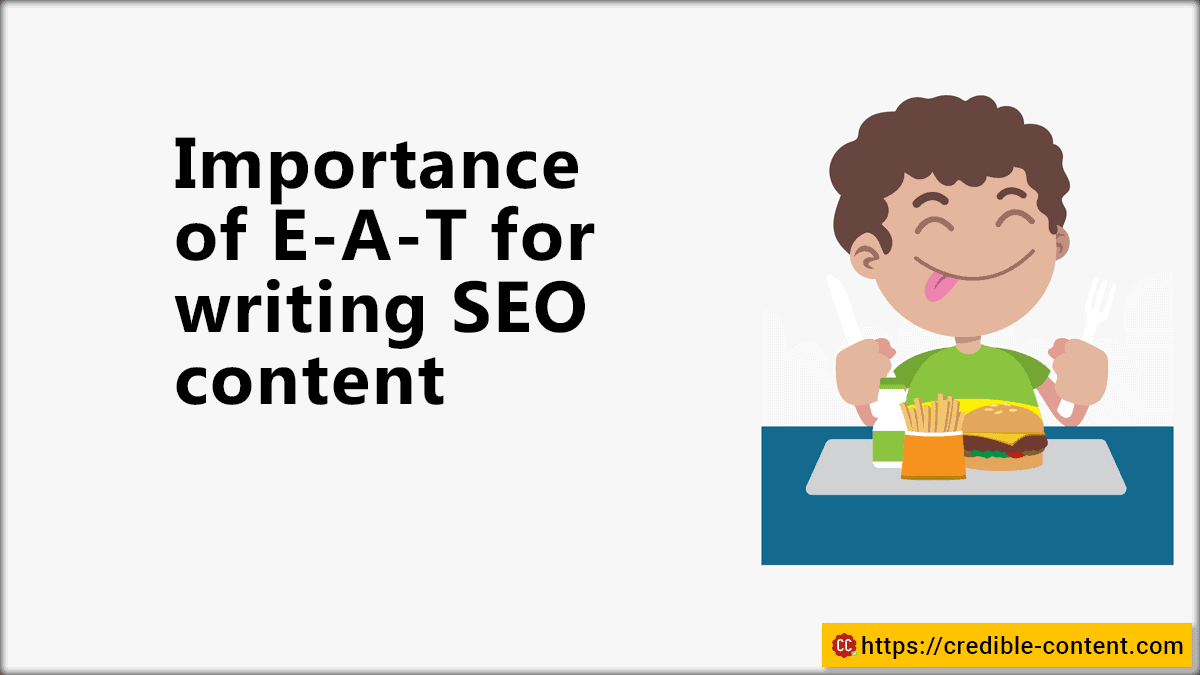The term E-A-T came to be recognized after major Google algorithm update in August 2018. E-A-T stands for Expertise, Authority, and Trustworthiness – three attributes of your content that help you improve your search engine rankings.
Theoretically these are not new concepts. For more than a decade now Google is increasingly making it difficult for websites to rank well, especially those websites that publish lots of random content just to improve their search engine rankings.
E-A-T is Google’s new standard to gauge the relevance of the content that you write. It isn’t simply the quality now. Sure, quality still matters, but in addition to quality, you also need to show your expertise, your authority, and the level of trust that people show in your content.
What exactly is Google E-A-T?
The expression E-A-T began to appear in various SEO articles after a major Google update in 2018. The finer nitty-gritty of the E-A-T part of the algorithm isn’t exactly clear to anyone but in this SEO guideline, Google seems to define “low quality pages” as pages “lacking expertise, authoritativeness, or trustworthiness”. Untrustworthy pages have the lowest E-A-T quotient.
To rank well, according to the Google update, the following needs to be considered:
- The level of expertise of the creator of the main content.
- The authoritativeness of the creator of the main content, the authoritativeness of the main content itself, and the authority of the website.
- The trustworthiness of the creator of the main content, the trustworthiness of the main content itself, and that of the website.
Expertise can be of two types:
- Something like a medical journal where highly expert people write about medicine and treatments.
- Less formal expertise such as restaurant or movie reviews.
It depends on how much the writers and their websites are trusted and believed by the readers and viewers.
The most important factors for E-A-T web pages may include
- The main content quality and quantity.
- The main beneficial purpose of the content (the web page or the blog post).
- The expertise, authoritativeness, and trustworthiness of the content as well as the content creator.
- The reputation of the website and the author.
How to write content according to Google’s E-A-T
Google’s intention is to find and showcase the most reliable and trustworthy information to its users. This is its reason to exist. If people don’t find trustworthy information, they will stop using the search engine and another search engine may fill the gap. You need to write content keeping that in mind. Here are a few things you can do
Write content based on search intent
Why are people looking for your content? Exactly what is the information they seek to solve their problems?
Further reading: What is search intent and how knowing it improves your SEO
When people are looking for content on my website they have to reasons
- They are looking for a professional content writer and copywriter.
- They want tips and information on content writing and copywriting so that they can either write themselves, or link to the blog post to add value to their own content.
When people link to my content it improves my search engine rankings. Also, when people are easily able to find my content on Google they more eagerly contact me for work thinking that I can achieve the same for them (which, on many occasions, I do).
Hence, whenever you are writing your content or editing existing content make sure why you are writing, what purpose it solves, and whether it delivers exactly what the readers are looking for.
Write blog posts and web pages in question-answer formats
The reason is quite simple. People are constantly asking Google questions and Google intends to provide answers. If you already write in question-and-answer format you deliver a ready-made template to Google.
Writing in the question answer format also helps you write according to the search intent. When you answer a question, you already know what you are writing about. Similarly, when people find your content on Google they already know what answer lies ahead, and more eagerly click your link, improving your CTR, and in the process, elevating your search engine rankings further.
Increase your authority as an author
This happens over a long period of time, but ultimately, it begins to have a bearing on your search engine rankings, especially considering E-A-T (the authority part). Do people refer to you as an expert? Do they mention you as an expert or an authority figure when they link to your content? Do they recommend you?
These things are interrelated. Unless you have content people are not going to find it and if they don’t find it, how do they know that you are an expert in your field?
Now, unless they know that you are an expert (based on E-A-T), how are you going to improve your search engine rankings so that they can find your content?
It may become a vicious loop, but it doesn’t have to be. You need to begin from somewhere.
Be active on social media. Use websites like Quora and LinkedIn. LinkedIn these days have many forums you can post your answers in and once you have built a presence, you can start sharing your content over there.
Pay close attention to search engine optimization when writing content
Don’t just write and publish content because you think you are an authoritative figure in your field. Yes, this definitely matters, but you need to make it easier for Google crawlers to crawl and index your content. For that, you need to follow some SEO conventions when writing and formatting your content.
What can you do?
Use an appropriate title that truly represents what you are writing. Preferably use your keywords or an SEO tool when formulating your title.
Use headings and subheadings like <h1>, <h2> and <h3>. Use <h1> just once for the main heading of your blog post or web page. You can use the subheading tags for multiple headings to make your content scannable.
Sometimes Google crawlers don’t go through your entire blog post or web page. They just skim through the headings and subheadings and bulleted points. Make sure you have useful information in these tags.
Why pay close attention to search engine optimization when writing content?
As I mentioned, it will make it easier for crawlers to make sense of your content and increase your chances of appearing in search results.
However low your rankings are, sooner or later people are going to find your content and start interacting with it. After that, your further rankings depend on how people interact with your content. This is where writing content according to search engine optimization standards is going to help you.
Find credible data and cite authoritative sources
Content writers, especially thought leaders, do lots of research when writing content. They find research data, quote it, and then link to the original sources. This renders credibility to their writing. It’s easier to trust numbers. Find information from multiple sources so that your readers don’t have to do that, and they can find all the credible information at the single source.
If you are an organization, you should also encourage your writers to improve their authoritativeness. You can invite well known authors to write for your blog. Write and publish lots of long form content because it is considered more authoritative and informative compared to thin content. Researching and citing sources also elevates your E-A-T factor.





